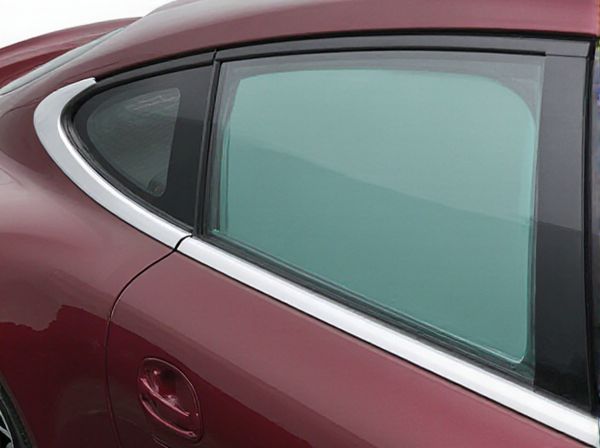
Photo illustration: Hydrophobic Coated Glass vs Non-Coated Glass
Hydrophobic coated glass repels water, reducing water spots and improving visibility during rain, while non-coated glass tends to accumulate water droplets and dirt more easily. The hydrophobic layer enhances durability by preventing corrosion and staining, making maintenance simpler and less frequent. Choosing hydrophobic coated glass ensures your surfaces stay clearer and cleaner with minimal effort.
Table of Comparison
| Feature | Hydrophobic Coated Glass | Non-Coated Glass |
|---|---|---|
| Water Repellency | High - water beads and rolls off quickly | Low - water spreads and reduces visibility |
| Visibility in Rain | Improved - clearer view during wet conditions | Reduced - water obstructs view |
| Maintenance | Low - easier to clean, resists dirt buildup | High - requires frequent cleaning |
| Durability | Long-lasting - resistant to weathering | Variable - can degrade over time |
| Cost | Higher - premium treatment | Lower - standard glass |
| Application | Ideal for car windows, improves safety | Standard usage, no special advantages |
Introduction to Hydrophobic Coated and Non-Coated Glass
Hydrophobic coated glass features a special surface treatment that repels water, preventing droplets from sticking and enhancing visibility and cleanliness. Non-coated glass lacks this treatment, resulting in water accumulation and increased maintenance requirements due to smudges and dirt. This coating significantly improves performance in applications exposed to weather or moisture, such as vehicle windshields and building windows.
How Hydrophobic Coating Works on Glass
Hydrophobic coating on glass creates a microscopic textured surface that repels water by minimizing contact between water molecules and the glass, causing droplets to bead up and roll off easily. This coating typically consists of silicon-based compounds that form a chemical bond with the glass, enhancing water resistance and reducing surface tension. In contrast, non-coated glass lacks this treatment, allowing water to spread evenly over the surface, leading to streaks and reduced visibility.
Water Repellency: Comparing Surface Behavior
Hydrophobic coated glass exhibits superior water repellency by causing water droplets to bead and roll off quickly, minimizing water marks and enhancing visibility. Non-coated glass tends to retain water droplets, resulting in streaks, smudges, and reduced clarity. The molecular structure of hydrophobic coatings creates a low surface energy layer that significantly reduces water adhesion compared to untreated glass surfaces.
Durability and Lifespan Differences
Hydrophobic coated glass exhibits enhanced durability by resisting water, dirt, and chemical stains, significantly prolonging its lifespan compared to non-coated glass. The coating reduces surface wear and prevents contaminants from causing micro-scratches and corrosion, maintaining clarity and structural integrity over time. Non-coated glass tends to degrade faster due to accumulation of grime and exposure to environmental factors, resulting in a shorter effective lifespan.
Maintenance and Cleaning Requirements
Hydrophobic coated glass repels water, dirt, and oil, significantly reducing the frequency and effort required for cleaning compared to non-coated glass, which accumulates grime more quickly. The self-cleaning properties of hydrophobic coatings prevent the buildup of hard water stains and make routine maintenance faster and less labor-intensive. Non-coated glass requires more frequent washing with stronger detergents and scrubbing to maintain clarity and hygiene.
Optical Clarity and Visual Performance
Hydrophobic coated glass significantly enhances optical clarity by repelling water, dirt, and smudges, reducing visual distortions and maintaining a clear viewing surface under various environmental conditions. Non-coated glass tends to accumulate moisture and debris, leading to frequent cleaning and potential degradation of visual performance due to streaks and spots. The advanced surface treatment of hydrophobic glass ensures superior glare reduction and improved light transmission, resulting in sharper and more consistent visual quality compared to non-coated alternatives.
Scratch and Stain Resistance
Hydrophobic coated glass offers superior scratch resistance compared to non-coated glass due to its durable protective layer that minimizes surface abrasions. Its stain resistance is significantly enhanced as the coating repels water, oils, and contaminants, preventing residue buildup and making cleaning easier. Non-coated glass lacks these protective properties, resulting in higher susceptibility to scratches and permanent stains over time.
Applications in Architecture and Automotive Industries
Hydrophobic coated glass enhances water repellency and reduces dirt accumulation, making it ideal for automotive windshields and architectural facades exposed to harsh weather conditions. Non-coated glass, while more cost-effective, requires frequent cleaning and maintenance in both industries due to its susceptibility to water spots and grime buildup. The hydrophobic coating improves visibility and reduces cleaning cycles, driving its adoption in smart building designs and modern vehicle manufacturing.
Cost Considerations: Initial and Long-term
Hydrophobic coated glass typically involves higher initial costs due to advanced surface treatments that repel water and reduce dirt accumulation. Over time, the long-term savings become evident as maintenance, cleaning frequency, and associated labor costs decrease significantly compared to non-coated glass. Non-coated glass, though cheaper upfront, often incurs higher ongoing expenses for cleaning and replacement caused by dirt buildup and potential water damage.
Choosing Between Hydrophobic and Non-Coated Glass
Hydrophobic coated glass repels water, reducing streaks, fogging, and maintenance effort, which makes it ideal for areas exposed to moisture or frequent cleaning such as car windshields and bathroom mirrors. Non-coated glass tends to accumulate water spots and dirt more easily but is generally more affordable and suitable for applications where water resistance is less critical. Choosing between hydrophobic and non-coated glass depends on the specific environmental exposure, maintenance preferences, and budget considerations.
 caratoz.com
caratoz.com